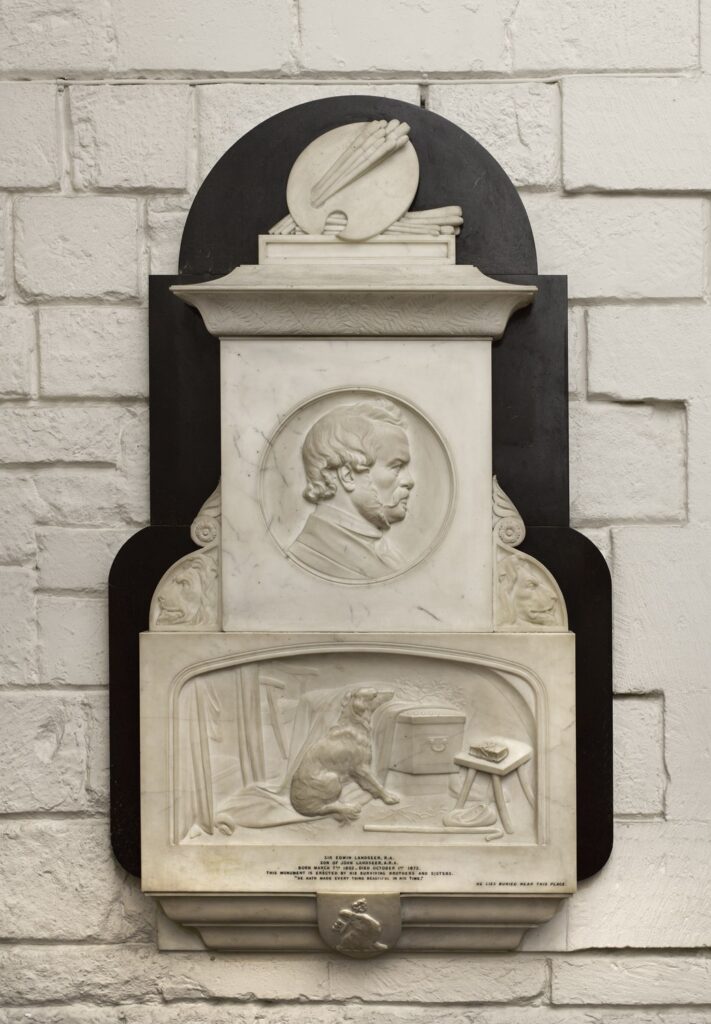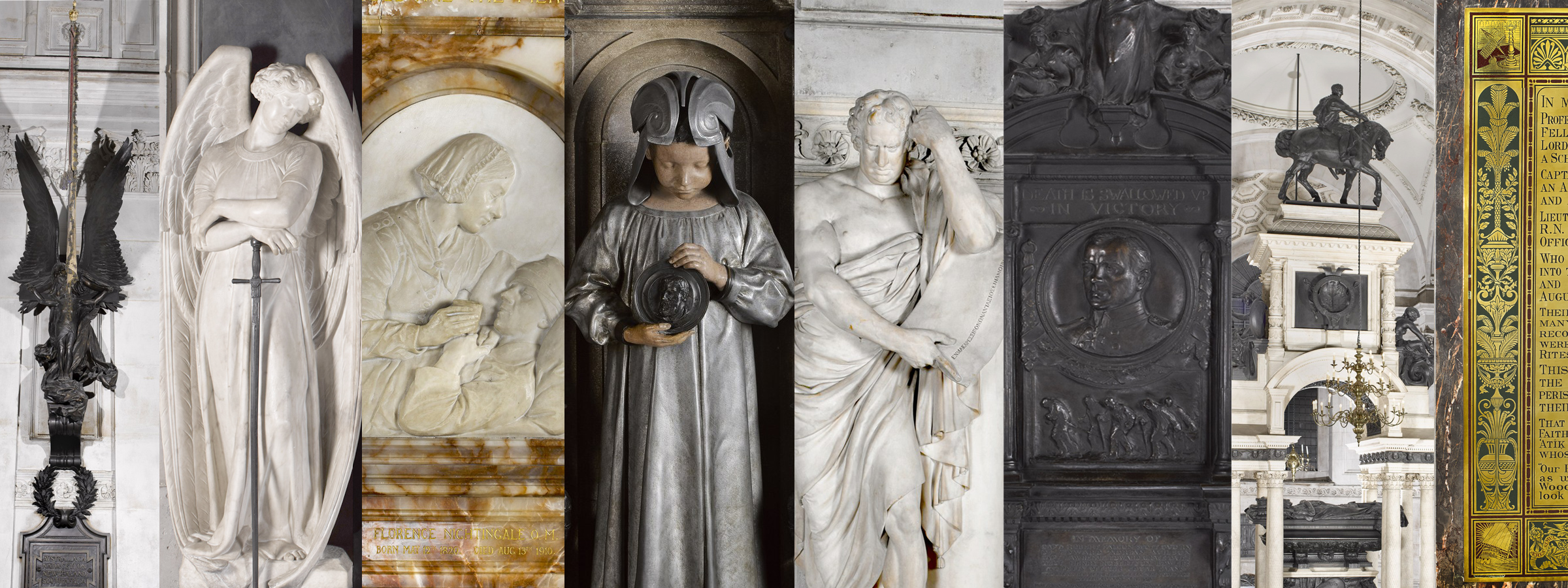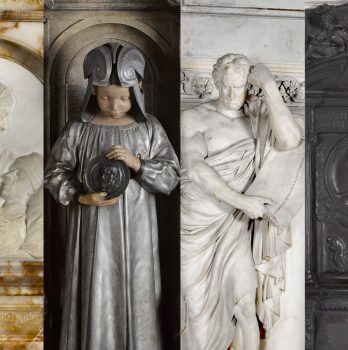Dr Emelia Quinn’s Response to the Monument to Sir Edwin Landseer RA (1802–1873) by Thomas Woolner RA, 1882

Dr Emelia Quinn 
Monument to Sir Edwin Landseer RA (1802–1873) by Thomas Woolner RA, 1882
‘Monument to Edwin Landseer’ – Transcript
Thomas Woolner’s 1882 monument to Sir Edwin Landseer is an homage to the famous British animal painter. Woolner’s mural re-creates Landseer’s famous portrait of canine fidelity in The Old Shepherd’s Chief Mourner (1837) below a profile of the artist’s bust, suggesting the dog as Landseer’s chief mourner, laying a wreath at the feet of his creator.
The dog directly mirrors Landseer, both centrally placed, looking to the right. Framed by the paintbrushes and pallet that crown the top of the monument, the dog is a metaphor for Landseer’s artistic output: a body of work that will live on and offer a faithful tribute to his life. The mural honours human sympathy and compassion and the role of art in enshrining such virtues. However, when considered in relation to a plethora of distinctly un-sentimental literary examples of mourning dogs, the Landseer mural leaves us contemplating whether humanity is worthy of memorialisation.
In Cervantes’ ‘The Dialogue of the Dogs‘ (1613), the talking dog Berganza explains that ‘I know very well there have been dogs so grateful that they have […] remained on the graves where their masters are buried and not moved from them, eating nothing, until they die.’ This characteristic canine self-sacrifice is contrasted with the deplorable humans that litter Berganza’s tale, from coarse slaughterhouse workers to shepherds who tear to pieces their sheep. Berganza’s further observation that ‘on alabaster tombs’ of married couples there is often a dog placed as a sign of their ‘friendship and fidelity’ provides an ironic contrast to the deceitful marriage preceding his tale.
Two centuries later, in Lord Byron’s apocalyptic poem ‘Darkness‘ (1816), the selfish and predatory nature of humankind, turning to cannibalism as the end of the world looms, contrasts the singular dog who alone is ‘faithful to a corse, and kept/The birds and beasts and famish’d men at bay’. Rather than lauding the bonds forged between humans and their domestic companion animals, Byron condemns the treachery of the human.
Similarly, the final lines of Thomas Hardy’s ‘The Mongrel‘ (1928), reversing the trope to feature a man witnessing the death of his dog, make clear that canine fidelity is misplaced: ‘The faith that had shone in that mongrel’s eye/That his owner would save him by and by/Turned to much like a curse as he sank to die,/And a loathing of mankind.’
Misanthropic leanings are also explicit across Landseer’s work. In Man Proposes, God Disposes (1864) two polar bears tear at the remains of an Arctic shipwreck, undermining the hubris of maritime exploration by recalling the cannibalism of the doomed Franklin Expedition. Woolner’s memorial may also show hints of this scepticism toward the dignity of humankind. Landseer’s leonine aspect, for instance, directly mirrors the two lions that flank his bust. His thick moustache mimics the lion’s snarling mouth, warning us that just beneath the surface veneer of human benevolence lies a vicious and predatory nature.
In our present age, where 150 billion animals are slaughtered for food each year and our planet teeters on the edge of ecological collapse, seemingly no amount of sentimental dog loving can ‘make beautiful’ the exploitative and near omnicidal relationship between humans and the natural world. It is perhaps appropriate, therefore, that the mural is located in the shadowed crypt of St Paul’s, where it receives so little light that Woolner complained that the human form of Landseer’s face was ‘obliterated as if in a dungeon’.
About Emelia Quinn
Dr Emelia Quinn is Assistant Professor of World Literatures & Environmental Humanities at the University of Amsterdam. Her research establishes the emergent field of vegan theory and its intersections with queer theory, animal studies, ecocriticism, and postcolonial studies. Her monograph, Reading Veganism: The Monstrous Vegan, 1818 to Present was published with Oxford University Press in September 2021.
Find Dr Emelia Quinn on Twitter.
About the Monument
When Sir Edwin Landseer died in 1873, his funeral cortege to St Paul’s Cathedral went past Trafalgar Square and the famous lions he had designed. They held wreaths in their mouths in his honour. Thomas Woolner (1825–1892), who incidentally was a founder member of the Pre-Raphaelites and one of their only sculptors, nods to the lions in his 1882 memorial at St Paul’s. He also recreated Landseer’s famous, emotionally charged painting The Old Shepherd’s Chief Mourner (1837), an early addition to the Victoria and Albert Museum’s collection: it’s a beautiful piece of relief sculpture in its own right, as well a fitting tribute to an artist who specialised in the anthropomorphic but realistic representation of animals, especially dogs and their relationships with humans.


